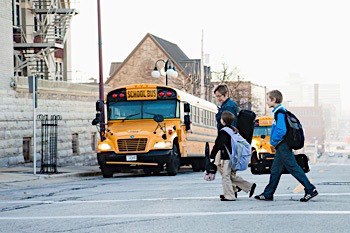 Two student transportation veterans spoke to the common goals they share with the Safe Routes to School (SRTS) National Partnership — and the positive results they’ve seen — during a recent webinar on collaboration.
Two student transportation veterans spoke to the common goals they share with the Safe Routes to School (SRTS) National Partnership — and the positive results they’ve seen — during a recent webinar on collaboration.
While SRTS programs are usually associated with districts’ efforts to encourage students to walk and ride bikes to and from school, both transportation directors said that promoting school bus ridership and ensuring safe routes to bus stops are also top priorities.
The free April 18 webinar, “Maximizing District-wide Impact of Safe Routes to School: Educating Student Transportation Departments,” was the fourth in a series that spotlights working champions helping to achieve SRTS aims. Program manager David Cowan moderated the discussion, which featured Peter Hurst, transportation options program specialist at Boulder Valley School District (BVSD) in Colorado, and Dan Pires, director of operations, transportation and risk management at Eureka City Schools (ECS) in California.
Bob Young, the director of transportation at BVSD is scheduled to present on “Safe Routes to Bus Stops” at the STN EXPO in Reno this July. Cowan previously told STN the national partership has been promoting a new strategy that links SRTS programs with transportation departments to prioritize improvements to bus stops or move them to increase students’ physical activity and overall safety.
Hurst started out as a school bus driver before working his way up to BVSD transportation specialist. With 170 days in the school year, he estimated that district parents who drive their own kids to and from school take 340 trips annually, and altogether, travel 31.6 million miles and spend $2.6 million on gas each year. The district serves about 30,000 students in 56 schools.
“Twenty percent of students actually use the school bus, so 24,000 are not riding — we estimate half of these get driven to school,” he said.
Hurst, who is responsible for all Safe Routes programming, told participants the district has won 16 grants and two Oberstar awards named after former House Transportation Committee Chair James Oberstar, who was a major proponent of SRTS. Yet, Hurst was quick to credit parent “champions” and supportive principals who have worked on programs like BLAST (Bike Lesson and Safety Training) and Heads Up Students (Mind the Crosswalk).
He stressed that his department has reaped many benefits from this partnership, including greater access to data and “heightened” communication with families as well as colleagues.
“Those of you who are trying to work with transportation, you know relationships are key. I can connect with principals, administrators, etc. … It’s really the best possible place to do this kind of work. I see this as a natural alliance,” Hurst said.
Currently more than 1,000 students participate in his department’s innovative Trip Tracker program, in which they earn Trip Tracker dollars and rewards for riding the bus, walking, biking or carpooling to school. “They love it and it’s had a big impact. We are saving over 300,000 vehicle miles a year — that’s a lot of car trips,” he added.
Handbooks as a Safety Tool
Pires began his student transportation journey in 1980, working in special-ed. transportation with Humboldt County before rising through the ranks to ECS transportation director. He joined the local Safe Routes task force in 2010, and the district won a grant that year to make improvements around Washington Elementary School.
“The task force is a group of diverse individuals from law enforcement, traffic engineering, the city council, city agencies and the county — all working on a common cause to make the area around the school safer for our schoolchildren,” said Pires. “I would strongly urge transportation folks to get involved in SRTS, as we all know transportation isn’t just school buses anymore.”
He emphasized that educating both parents and students is key to minimizing hazards such as unsafe driving in school zones and along school bus routes.
“My job is to teach parents and children about safe ways to get to and from the school bus stops as well. The Safe Routes program gave me additional information to include in parent handbooks, such as maps showing best walking routes to school bus stops, showing where there were protected intersections with traffic lights and not just stop signs,” he continued.
During the Q&A that closed the webinar, participants asked for more specifics on what to include in parent handbooks — and his co-presenter, Hurst, requested a copy of ECS’s actual handbook. In this handbook, Pires provides information on who qualifies for busing, how to get to the bus stop safely, what to do when you get to the bus stop, rules for riding the school bus and info on walking and biking to school, such as where to buy a bike helmet.
“In addition to walking maps for schools that currently have [SRTS programs], we’re making walking maps for all the other schools and giving information about how traffic flows around schools and through parking lots, tips about not double-parking, how to safely exit the pickup/drop-off lane or parking lot, where school buses will be and the list goes on,” he continued. “We’ve shown these techniques really work by getting that info out to parents.”
Pires added that the Safe Routes program has been “very successful” in his Northern California distict and, in fact, Eureka recently received another grant.
“I hope all of the people involved in school transportation see this as a benefit,” he said. “The Safe Routes folks in my community have definitely made my job easier. Anything the schools need, they are there to help with.”


















